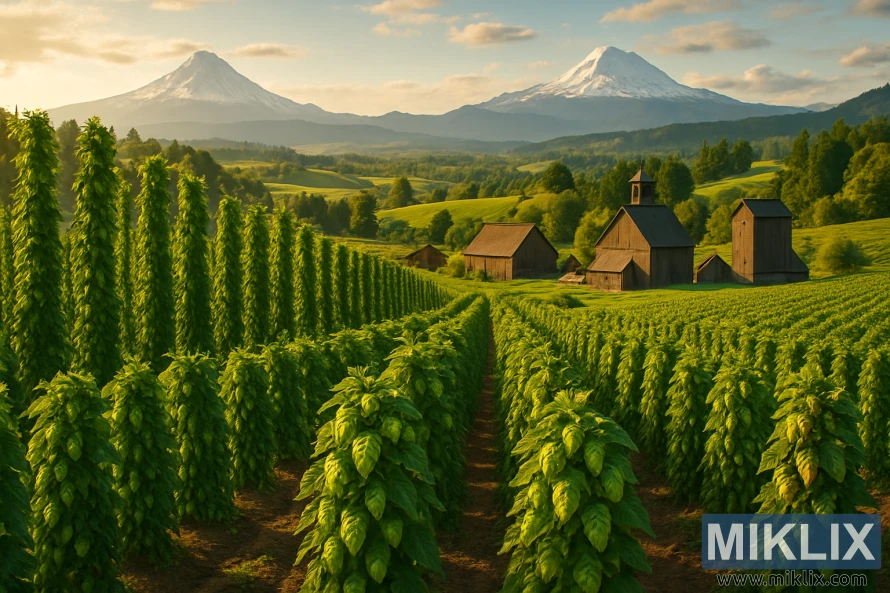Image: Willamette Valley Hop Fields
Published: August 4, 2025 at 4:51:51 PM UTC
Last updated: September 27, 2025 at 9:52:37 AM UTC
Sunlit hop fields of the Pacific Northwest with rustic barns and Cascade Mountains in the distance, capturing the essence of Willamette hop cultivation.
The image before us captures the Pacific Northwest at its most enchanting, where agriculture and landscape blend seamlessly into a tableau of abundance and timeless beauty. The foreground is dominated by meticulously cultivated rows of hops, their verdant bines climbing tall trellises with purposeful vigor, each plant heavy with clusters of ripening cones. The leaves catch the light in subtle gradients of green, their textured surfaces shimmering under the golden rays of the setting sun. Gentle breezes ripple through the bines, setting the cones swaying like pendulums, their motion reinforcing the sense of life and vitality that radiates throughout the scene. These hops are not merely crops—they are symbols of the region’s legacy in brewing, each plant a testament to the generations of farmers who have nurtured them into one of the Pacific Northwest’s most celebrated agricultural treasures.
As the eye travels further, the midground unfolds with rustic charm, where weathered hop barns and kilns dot the landscape. Their dark wooden exteriors bear the marks of years spent in service, harmonizing effortlessly with the lush fields that surround them. Some structures stand tall and angular, their steep roofs designed to withstand the rains that sweep through this fertile valley, while others are squat and sturdy, their silhouettes softened by age and familiarity. The arrangement of these buildings speaks of function and tradition, reminders of the human presence that has shaped this land without overpowering its natural splendor. The warm light of late afternoon bathes the barns, highlighting their rugged textures and drawing out the interplay between wood and shadow. This balance of utility and beauty forms the heart of the agricultural rhythm, where crops are not just grown but shepherded with knowledge, patience, and care.
Beyond the fields and barns, the land rolls outward into a series of soft, undulating hills, blanketed in a patchwork of forests, meadows, and farmland. Each fold of the terrain is painted in varying shades of green, deepened by the low angle of the sun. The valleys cradle quiet groves, while the crests open into vistas that sweep the eye ever further toward the horizon. The gentle topography creates a natural cadence, as though the earth itself breathes in a slow, steady rhythm, exhaling a sense of peace that permeates the entire scene.
And then, rising above it all, the Cascade Mountains command the horizon with a grandeur both humbling and inspiring. Their snow-capped summits gleam in the golden light, etched in sharp relief against a sky softened by drifting clouds. The peaks tower with a serene majesty, their forms both eternal and ephemeral, constantly shifting under the play of light and shadow. They serve as both guardians and symbols, reminders of the natural forces that shape this land and the resilience required to thrive within it. The contrast between the fertile hop fields in the valley and the austere, icy summits in the distance encapsulates the Pacific Northwest’s duality: a place of both nurturing abundance and rugged challenge.
The atmosphere of the scene is defined by tranquility and richness, a harmony between human endeavor and natural wonder. The golden light of evening saturates the landscape with warmth, deepening colors and softening edges, lending everything an almost painterly quality. The air itself seems thick with the scent of hops, mingled with the freshness of mountain breezes descending into the valley. Every element—the swaying bines, the rustic barns, the rolling hills, the distant peaks—contributes to a sense of place that is both specific and universal, at once tied to the Willamette Valley and resonant with the broader spirit of agricultural life.
In this vision of the Pacific Northwest hop fields, the viewer is invited not just to admire but to immerse themselves in the scene. It is an image that speaks to abundance and stewardship, to the enduring relationship between farmer and land, and to the way landscapes can carry the essence of culture and tradition. The rows of hops, the barns, the mountains—they are not isolated features but interconnected parts of a living tapestry that continues to evolve, season by season, generation by generation, under the warm gaze of the sun and the watchful eye of the mountains.
The image is related to: Hops in Beer Brewing: Willamette

